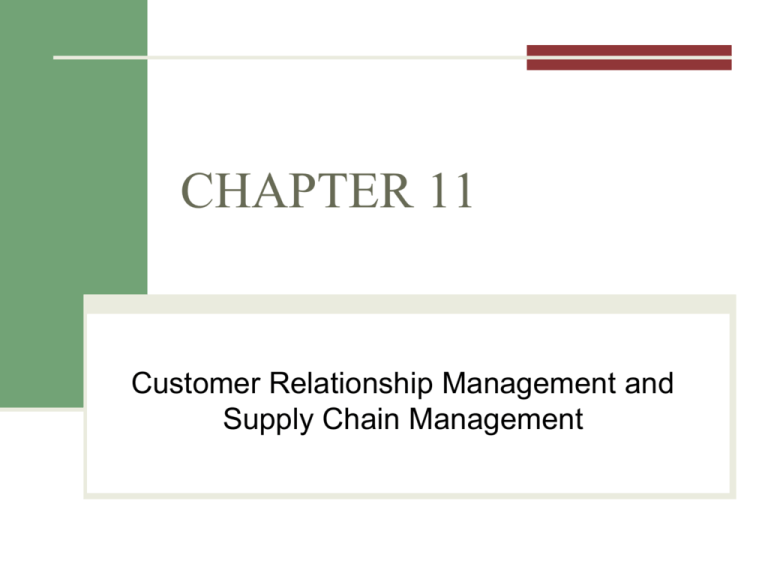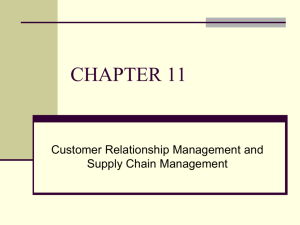CHAPTER 11
advertisement

CHAPTER 11 Customer Relationship Management and Supply Chain Management Announcements Today Chapter 11 – CRM and SCM Project 6 – Solver Case due by midnight Review Project 7 – Decision Support Review of all functions and formulas used Coming Weeks Quiz 3 – Excel Solver Chapter 12 & Tech Guide 4 Final Exam Review CHAPTER OUTLINE 11.1 Defining Customer Relationship Management 11.2 Operational CRM Systems 11.3 Analytical CRM Systems 11.4 Other Types of CRM Systems 11.5 Supply Chains 11.6 Supply Chain Management 11.7 IT Support for Supply Chain Management Chapter Opening Case: The Next Step in Customer Relationship Management Source: Maxx-Studio/Shutterstock Taste Profiling Persuasion Profiling 11.1 Customer Relationship Management Customer-Focused & Customer-Driven Designed to Achieve: Customer Intimacy From Neighborhood Stores……. © MONKEY BUSINESS-LBR/Age Fotostock America, Inc. Personal ….To Today Mobile population The Web Giant malls Impersonal Why do we need CRM? Cost Dissatisfied customer impacts Increasing the customer retention rate Odds of selling to new customers Retention of complaining customers Why do we need CRM? Value of a customer Duration of the relationship Number of relationships (e.g. more than one product) Profitability of the relationship GOAL of CRM: Maximize lifetime value of a customer Tenets of CRM One-to-one relationship between a customer and a seller. Treat different customers differently. Keep profitable customers and maximize lifetime revenue from them. Customer Touch Points Data Consolidation Accounting HR Finance Customer Marketing MIS Data Consolidation = 360-Degree View of Customers Collaborative CRM Primary Components of a CRM Strategy Customer-facing Applications O P E R A T I O N A L • • • • Sales Marketing Customer Service and Support Campaign Management Customer Data Warehouse Customer-touching Applications • Search and Comparison • • • • • • Customized Products Technical Information Personalized Web Pages FAQ E-mail / Auto Response Loyalty Programs • • • • Data Mining Decision Support Business Intelligence OLAP A N A L Y T I C A L 11.2 Operational CRM Supports the front-office business processes (i.e. those that directly interact w/customers) Marketing List Generator Campaign Mgmt Cross Selling / Up Selling Sales Sales Mgmt Contact Mgmt Opportunity Mgmt Customer Service Contact Center Web-Based Self Service Call Scripting Two major components: 1. 2. Customer-facing applications Customer-touching applications Operational CRM: Customer-Facing Applications Customer service and support Sales force automation Marketing • Cross Selling • Up Selling • Bundling Campaign management © Mustafa Almir Mahmoud/Age Fotostock America, Inc. Operational CRM: Customer-Touching Applications • Search and comparison capabilities • Technical and other information and services • Customized products and services Source: © Spencer Grant/PhotoEdit • Loyalty programs 11.3 Analytical CRM Systems Analyze customer behavior and perceptions in order to provide actionable business intelligence. Customer Data Warehouse • • • • Data Mining Decision Support Business Intelligence OLAP A N A L Y T I C A L 11.4 Other Types of Customer Relationship Management Systems On-demand CRM Hosted by an external vendor in the vendor’s data center Mobile CRM Interacting directly with customers through mobile devices Open-source CRM Source code openly available to developers and users Challenges and Future of Customer Relationship Management Systems Challenges • Social Media Future • Supplier Relationship Management • Partner Relationship Management • Employee Relationships Management 11.5 Supply Chains The flow of materials, information, money, and services from raw material suppliers, through factories and warehouses, to the end consumers. Components of Supply chain: The Flows of the Supply Chain Material flows Information flows Financial Financial flows Information Material 11.6 Supply Chain Management The function of planning, organizing, and optimizing the various activities performed along the supply chain These systems are considered to be a type of Interorganizational information system (IOS). Goal of an SCM System: Reduce problems along supply chain Push & Pull Models Problems Along the Supply Chain Problems: Poor customer service Poor quality product High inventory costs Loss of revenues The Bullwhip Effect Solutions to Supply Chain Problems Using inventories: Just-in-time inventory Information sharing: Vendor-managed inventory 11.7 Information Technology Support for Supply Chain Management Electronic data interchange (EDI) Enables business partners to exchange routing documents electronically Example EDI is accomplished through the use of Extranets The main goal of extranets is to foster collaboration between business partners. An extranet is open to selected B2B suppliers, customers and other business partners. The Structure of an Extranet Comparing Purchase Order Fulfillment Without EDI Source: Drawn by E. Turban Comparing Purchase Order Fulfillment With EDI Source: Drawn by E. Turban EDI Benefits Minimize data entry errors Length of messages are shorter Messages are secured Reduces cycle time Increases productivity Enhances customer service Minimizes paper usage and storage EDI Limitations Significant initial investment to implement Ongoing operating costs are high due to the use of expensive, private VANs Traditional EDI system is inflexible Long startup period Multiple EDI standards exist







